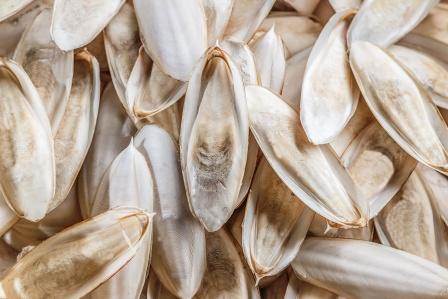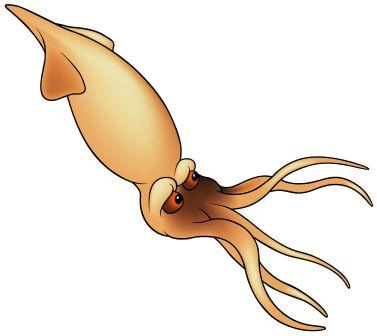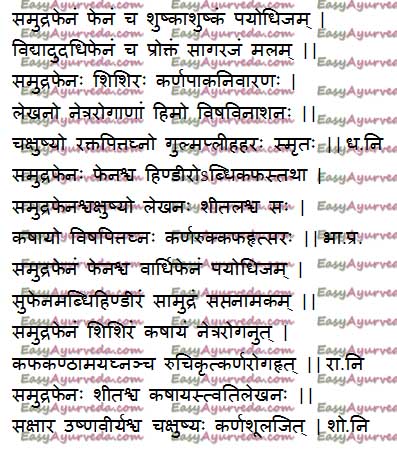Samudra Fen – Cuttle Fish Bone Benefits, Research, Side Effects
Samudra Fen is an animal product obtained from the cuttle fish. The bone of the fish floats on the sea water after the death of the fish. When large number of bones floats together over the surface of sea water, it looks like froth of sea water from a distance. Hence the name samudraphena; samudra indicating sea and phena indicating froth.
The bone of the dead fish being light in weight floats over the surface and sometimes reaches the shore. This by – product of the cuttle fish is collected by the fishermen from sea or sea shore and dried under sunlight. Later it is used by artisans for craft, painting or in medicine.
Table of Contents
Appearance
Appearance of Samudrafen:
It looks pale white or ivory white depending upon the area of collection. It is flat with a slight bulge in the middle and slightly rough edges and smooth surface. It is light in weight due to which it floats over the surface of sea water.

Vernacular names
Indian vernacular names:
Hindi name – Samudra fen
English name – Cuttle Fish Bone
Arabian name – Jubadullahere, Jabdul Baher
Bengali name – SamudrerPhena, Samudraphela
Gujarati name – Samudraphina
Kannada name – Samudra nalige
Malayalam name – Kadala neere
Marathi name – Samudraphen
Punjabi name – Samundrajhag
Tamil name – Kadala neere
Telugu name – Soru penaka, Samudra Punarugu

Chemical composition
Samudrafena contains mainly Calcium carbonate (80 – 85 %). Apart from this it also contain Phosphate, Sulphate and Silica in various concentration.
Properties, dose, adjuvant
Properties of Samudrafena:
Rasa (Taste) – Kashaya (Astringent)
Guna (Quality) – Ruksha (Dryness)
Veerya (Potency) – Sheeta (Cold)
Vipaka – Katu (Undergoes Pungent taste after digestion)
Karma (Main action): Lekhana (Scrape), Deepana (appetizer) , Pachana (remove/digest ama dosha)
Dose: 250 – 500 mg
Anupana (Adjuvant): Madhu (Honey) or water
Purification method
Shodhana method (Purification method):
Shodhana (Purification) of samudraphena is needed if it is used for medicinal use. Dried samudraphena is taken in a motar and powdered using a pestle. Later ‘bhavana’ (grinding) is done with equal quantity of lime juice till the powdered samudraphena gets properly dried.
Uses of samudraphena
- Powdered samudraphena is mixed with honey in a dose of 250 – 500 mg and given to patients suffering from cough associated with phlegm.
- Powder of samudraphena is used like a dusting powder in conditions of suppuration of wounds and pus discharge from the ear and other wounds.
- Powder of samudraphena is mixed with goat milk and applied as collyrium to the eyes for improving the vision and removal of excess kapha dosha from the ocular region.
- In condition of eczema and other fungal condition affecting the skin, the powder of samudraphena is sprinkled over the affected area or applied by mixing with any ‘kushtahara’ dravya juice.
- The powder of samudraphena, in a dose of 500 mg is given to treat condition of Irritable bowel syndrome.
- Samudraphena powder is mixed with rose water and applied as collyrium to treat conjunctivitis and burning sensation of the eyes.
- Samudraphena powder is used like tooth powder to treat gingivitis and dental caries.
- To relieve burning sensation of the body, samudraphena powder is mixed with rose water and consumed in a dose of 500 mg.
- Read related: Cuttlefish Bone (Samudraphena) Remedies: Eyes Burning, Earache, Tartar
Sanskrit verse

Traditional uses, Indications
Traditional uses:
Shishira – coolant
Lekhana – has scraping property, useful in balancing Kapha, in respiratory disorders and in cholesterol / clot deposition in blood vessels
Chakshushya – improves vision, good for eyes, useful in eye disorders
Indicated in –
Karnapaka – pus discharge from ears
Netraroga – eye disorders with discharge
Visha – Toxic conditions, poisoning
Raktapitta –Bleeding disorders such as nasal bleeding, heavy periods, etc
Gulma – Tumors of the abdomen
Pleeha – Disease of the spleen, Splenomegaly
Kanthamaya – throat disorders, voice disorders
Adverse effect
People suffering from dry cough or having weak body structure may avoid taking samudraphena.
Interaction with medicines, supplements
Can this be used while taking Homeopathic medicine?
Yes. This product does not react with homeopathic medicine.
Can this medicine be continued while taking supplements like multivitamin tablets, Omega 3 fatty acids etc?
Yes. Generally, this product goes well with most of the dietary supplements. However, if you are taking more than one product per day, please consult your doctor for an opinion.
With western medicines
Seek your doctor’s advice if you are taking this product along with other western (allopathic / modern) medicines. Some Ayurvedic herbs can interact with modern medicine.
If both Ayurvedic and allopathic medicines are advised together, then it is best to take Allopathic medicine first, wait for 30 minutes and then take the Ayurvedic medicine.
Research
Research articles related to Sepia officinalis:
Anti – bacterial and anti – septic effect: The present investigation aims to evaluate the in vitro and in vivo antibacterial and antiseptic efficacy of Sepia officinalis body tissue (SOBT) extract and S. officinalis polysaccharide (SOP) from its cuttlebone. The present study revealed that the SOBT and SOP extracts showed in vitro bactericidal activity against gram – positive and gram – negative bacteria. Furthermore, administration of SOBT and SOP increased the rats’ survival rates by 66.7% and 83.33%, respectively, as compared to the untreated CLP – septic rats. Treatment of the CLP – septic rats with SOBT and SOP significantly alleviated alterations in procalcitonin levels and in some hematological parameters induced by CLP.
Anti – oxidative property: Anti – oxidative activities and biochemical properties of protein hydrolysates prepared from cuttlefish (Sepia officinalis) using Alcalase 2.4 L and Bacillus licheniformis NH1 proteases with different degrees of hydrolysis (DH) were determined. The antioxidant activities of cuttlefish protein hydrolysates (CPHs) increase with increasing DH. In addition, all CPHs exhibited anti – oxidative activity in a concentration – dependent manner. NH1 – CPHs generally showed greater anti – oxidative activity than Alcalase protein hydrolysates.
Scientific classification
Kingdom: Animalia
Phylum: Mollusca
Class: Cephalopoda
Order: Sepiida
Family: Sepiidae
Genus: Sepia
Subgenus: Sepia
Species: S. officinalis
Classical categorization
Dhanvantari Nighantu – Chandanadi Varga
Bhavaprakasha – Haritakyadi Varga
Raja Nighantu – Pippalyadi Varga
Shodala Nighantu – Chandanadi Varga
Sanskrit Synonyms
Phenaka, Abdiphena, Abdikapha, Saphena – Frothy in appearance
Payodhija, Suphena,
Abdhihindeera, Abdhi Kapha, Saamudra, Sagaraja – obtained from sea
Author: Dr.B.K.Prashanth M.D (Ayu), Ph.D
E mail: [email protected]
Click to consult Dr Prashanth BK
Table of Contents
Toggle panel: Table of Contents
| Disable the automatic insertion of the table of contents. | |
| Advanced: | NOTE:Using the advanced options below will override the global advanced settings. |
| Headings: | Heading 1 (h1) Heading 2 (h2) Heading 3 (h3) Heading 4 (h4) Heading 5 (h5) Heading 6 (h6) Select the heading to consider when generating the table of contents. Deselecting a heading will exclude it. |
| Alternate Headings | Specify alternate table of contents header string. Add the header to be replaced and the alternate header on a single line separated with a pipe |. Put each additional original and alternate header on its own line. |
Examples:Level [1.1]|Alternate TOC Header Replaces Level [1.1] in the table of contents with Alternate TOC Header.Note: This is case sensitive. | |
| Exclude Headings | Specify headings to be excluded from appearing in the table of contents. Separate multiple headings with a pipe |. Use an asterisk * as a wildcard to match other text. |
Examples:Fruit* Ignore headings starting with “Fruit”.*Fruit Diet* Ignore headings with “Fruit Diet” somewhere in the heading.Apple Tree|Oranges|Yellow Bananas Ignore headings that are exactly “Apple Tree”, “Oranges” or “Yellow Bananas”.Note: This is not case sensitive. |
Yoast SEO Premium
Toggle panel: Yoast SEO Premium
Focus keyphraseHelp on choosing the perfect focus keyphrase(Opens in a new browser tab)
Google preview
Preview as:Mobile resultDesktop resultUrl preview: www.easyayurveda.com › 2018 › 05 › 03 › samudra-fen-cuttle-fish-boneSEO title preview:Samudra Fen – Cuttle Fish Bone Benefits, Research, Side EffectsMeta description preview:
www.easyayurveda.com › 2018 › 05 › 03 › samudra-fen-cuttle-fish-boneSEO title preview:Samudra Fen – Cuttle Fish Bone Benefits, Research, Side EffectsMeta description preview:

May 3, 2018 - Samudra Fen is an animal product obtained from the cuttle fish. The bone of the fish floats on the sea water after the death of the fish. When large …SEO titleInsert variableSamudra Fen – Cuttle Fish Bone Benefits, Research, Side EffectsSlugMeta descriptionInsert variableSamudra Fen is an animal product obtained from the cuttle fish. The bone of the fish floats on the sea water after the death of the fish. When large number of bones floats together over the surface of sea water, it looks like froth of sea water from a distance.
SEO analysisOKSamudra Fen
Add related keyphrase
Track SEO performance
Insights
Advanced
Custom AMP Editor
Toggle panel: Custom AMP Editor
AMP Page Builder
Toggle panel: AMP Page Builder
Sanskrit verse

Traditional uses, Indications
Traditional uses:
Shishira – coolant
Lekhana – has scraping property, useful in balancing Kapha, in respiratory disorders and in cholesterol / clot deposition in blood vessels
Chakshushya – improves vision, good for eyes, useful in eye disorders
Indicated in –
Karnapaka – pus discharge from ears
Netraroga – eye disorders with discharge
Visha – Toxic conditions, poisoning
Raktapitta –Bleeding disorders such as nasal bleeding, heavy periods, etc
Gulma – Tumors of the abdomen
Pleeha – Disease of the spleen, Splenomegaly
Kanthamaya – throat disorders, voice disorders
Adverse effect
People suffering from dry cough or having weak body structure may avoid taking samudraphena.
Interaction with medicines, supplements
Can this be used while taking Homeopathic medicine?
Yes. This product does not react with homeopathic medicine.
Can
this medicine be continued while taking supplements like multivitamin tablets,
Omega 3 fatty acids etc?
Yes. Generally, this product goes well with most
of the dietary supplements. However, if you are taking more than one product
per day, please consult your doctor for an opinion.
With western
medicines
Seek your
doctor’s advice if you are taking this product along with other western
(allopathic / modern) medicines. Some Ayurvedic herbs can interact with modern
medicine.
If both Ayurvedic and allopathic medicines are advised together, then it is
best to take Allopathic medicine first, wait for 30 minutes and then take the
Ayurvedic medicine.
Research
Research articles related to Sepia officinalis:
Anti – bacterial and anti – septic effect: The present investigation aims to evaluate the in vitro and in vivo antibacterial and antiseptic efficacy of Sepia officinalis body tissue (SOBT) extract and S. officinalis polysaccharide (SOP) from its cuttlebone. The present study revealed that the SOBT and SOP extracts showed in vitro bactericidal activity against gram – positive and gram – negative bacteria. Furthermore, administration of SOBT and SOP increased the rats’ survival rates by 66.7% and 83.33%, respectively, as compared to the untreated CLP – septic rats. Treatment of the CLP – septic rats with SOBT and SOP significantly alleviated alterations in procalcitonin levels and in some hematological parameters induced by CLP.
Anti – oxidative property: Anti – oxidative activities and biochemical properties of protein hydrolysates prepared from cuttlefish (Sepia officinalis) using Alcalase 2.4 L and Bacillus licheniformis NH1 proteases with different degrees of hydrolysis (DH) were determined. The antioxidant activities of cuttlefish protein hydrolysates (CPHs) increase with increasing DH. In addition, all CPHs exhibited anti – oxidative activity in a concentration – dependent manner. NH1 – CPHs generally showed greater anti – oxidative activity than Alcalase protein hydrolysates.
Scientific classification
Kingdom: Animalia
Phylum: Mollusca
Class: Cephalopoda
Order: Sepiida
Family: Sepiidae
Genus: Sepia
Subgenus: Sepia
Species: S. officinalis
Classical categorization
Dhanvantari Nighantu – Chandanadi Varga
Bhavaprakasha – Haritakyadi Varga
Raja Nighantu – Pippalyadi Varga
Shodala Nighantu – Chandanadi Varga
Sanskrit Synonyms
Phenaka, Abdiphena, Abdikapha, Saphena – Frothy in appearance
Payodhija, Suphena,
Abdhihindeera, Abdhi Kapha, Saamudra, Sagaraja – obtained from sea
Author: Dr.B.K.Prashanth M.D (Ayu), Ph.D
E mail: [email protected]
Click to consult Dr Prashanth BK











2 comments
Faraz ahmed
Sir, Samudraphen is veg or non veg?
Dr J V Hebbar MD(Ayu)Author
It is non-veg.